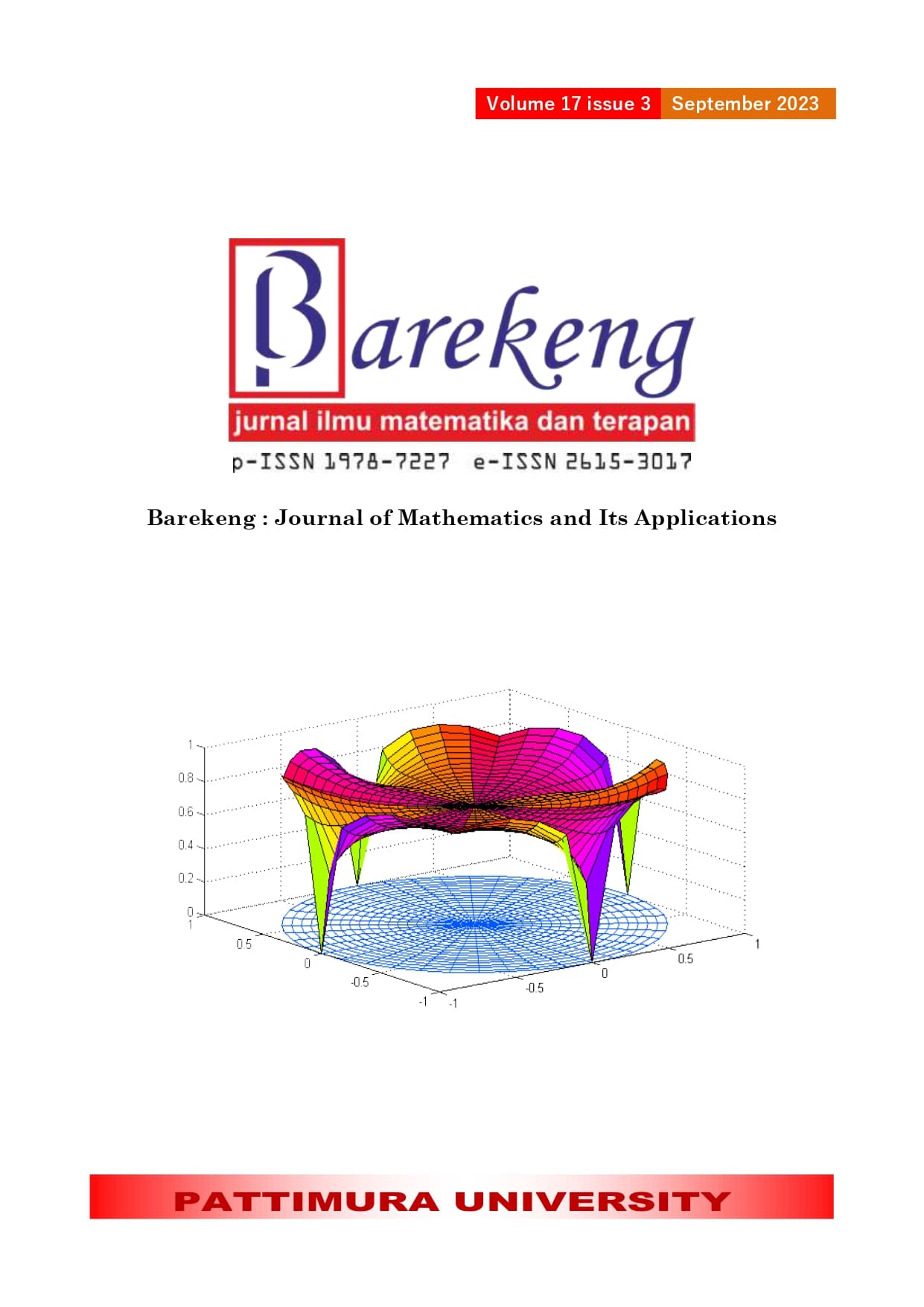CRYPTOCURRENCY PRICE PREDICTION: A HYBRID LONG SHORT-TERM MEMORY MODEL WITH GENERALIZED AUTOREGRESSIVE CONDITIONAL HETEROSCEDASTICITY
Abstract
Cryptocurrency is a virtual payment instrument currently popular as an investment alternative. One type of cryptocurrency widely used as an investment is Bitcoin due to its high-profit potential and risk due to unstable exchange rate fluctuations. This high exchange rate fluctuation makes trading transactions in the crypto market speculative and highly volatile. To overcome this volatility factor, this research used the Generalized Autoregressive Conditional Heteroscedasticity forecasting method to describe the heteroscedasticity factor, as well as a Recurrent Neural Network (RNN) with long-short-term memory that has feedback in modeling sequential data for time series analysis. The two methods are combined to overcome the dependency of time series data in the long term and the heteroscedastic effect of the volatility of price changes. The results of the GARCH-LSTM hybrid model in this study show a Mean Absolute Percentage Error (MAPE) value of 15.69%. The accuracy value is obtained from the division of training data by 80% and testing data by 20%, with the number of neurons as many as three and epochs of 100 using the Adam optimizer. The MAPE accuracy results show a good prediction in predicting the value.
Downloads
References
A. Agrawal and K. Hockerts, “Impact investing: review and research agenda,” J. Small Bus. Entrep., vol. 33, no. 2, pp. 153–181, 2021, doi: 10.1080/08276331.2018.1551457.
A. Faturahman, V. Agarwal, and C. Lukita, “Blockchain Technology - The Use Of Cryptocurrencies In Digital Revolution,” IAIC Trans. Sustain. Digit. Innov., vol. 3, no. 1, pp. 53–59, 2021, doi: 10.34306/itsdi.v3i1.523.
K. H. Al-Yahyaee, W. Mensi, H. U. Ko, S. M. Yoon, and S. H. Kang, “Why cryptocurrency markets are inefficient: The impact of liquidity and volatility,” North Am. J. Econ. Financ., vol. 52, no. February, p. 101168, 2020, doi: 10.1016/j.najef.2020.101168.
R. Bhowmik and S. Wang, “Stock market volatility and return analysis: A systematic literature review,” Entropy, vol. 22, no. 5, pp. 1–18, 2020, doi: 10.3390/E22050522.
A. P. Raneo and F. Muthia, “Penerapan Model GARCH Dalam Peramalan Volatilitas di Bursa Efek Indonesia,” J. Manaj. Dan Bisnis Sriwij., vol. 16, no. 3, pp. 194–202, 2019, doi: 10.29259/jmbs.v16i3.7462.
A. Auti, D. Patil, O. Zagade, P. Bhosale, and P. Ahire, “Bitcoin Price Prediction Using Svm,” Int. J. Eng. Appl. Sci. Technol., vol. 6, no. 11, pp. 226–229, 2022, doi: 10.33564/ijeast.2022.v06i11.042.
H. Young and C. Hyun, “Forecasting the volatility of stock price index : A hybrid model integrating LSTM with multiple GARCH-type models,” Expert Syst. Appl., vol. 103, pp. 25–37, 2018, doi: 10.1016/j.eswa.2018.03.002.
S. N. Alawiyah, “Pemodelan Menggunakan Pendekatan Recurrent Neural Network Long Short Term Memory (Rnnlstm) Pada Harga Emas Dunia,” 2021, [Online]. Available: http://repository.unimus.ac.id/id/eprint/4855
M. Al Haris, “Peramalan Harga Emas Dengan Model Generalized Autoregressive Conditional Heteroscedasticity (Garch),” J. Saintika Unpam J. Sains dan Mat. Unpam, vol. 3, no. 1, p. 19, 2020, doi: 10.32493/jsmu.v3i1.5263.
K. Worden, I. Iakovidis, and E. J. Cross, “On stationarity and the interpretation of the ADF statistic,” Conf. Proc. Soc. Exp. Mech. Ser., vol. 2, pp. 29–38, 2019, doi: 10.1007/978-3-319-74421-6_5.
W. Rahayu and B. Sumargo, “Forecasting the Number of Foreign Tourist Using Intervention and ARCH Analysis,” AIP Conf. Proc., vol. 2588, no. October 2018, 2023, doi: 10.1063/5.0113461.
H. Hassani and M. R. Yeganegi, “Sum of squared ACF and the Ljung–Box statistics,” Phys. A Stat. Mech. its Appl., vol. 520, pp. 81–86, 2019, doi: 10.1016/j.physa.2018.12.028.
G. Van Houdt, C. Mosquera, and G. Nápoles, “A review on the long short-term memory model,” Artif. Intell. Rev., vol. 53, no. 8, pp. 5929–5955, 2020, doi: 10.1007/s10462-020-09838-1.
H. Salman, J. Grover, and T. Shankar, “Hierarchical Reinforcement Learning for Sequencing Behaviors,” vol. 2733, no. March, pp. 2709–2733, 2018, doi: 10.1162/NECO.
M. W. P. Aldi, Jondri, and A. Aditsania, “Analisis dan Implementasi Long Short Term Memory Neural Network untuk Prediksi Harga Bitcoin,” J. Inform., vol. 5, No, no. 2, p. 3548, 2018, [Online]. Available: http://openlibrarypublications.telkomniversity.ac.id
S.-M. Liu and B. W. Brorsen, “Maximum Likelihood Estimation of a Garch-Stable Model,” J. Appl. Econom., vol. 10, no. 3, pp. 273–285, Aug. 1995, [Online]. Available: http://www.jstor.org/stable/2285166
S. J. Reddi, S. Kale, and S. Kumar, “ON THE CONVERGENCE OF ADAM AND BEYOND,” Int. Conf. Learn. Represent., vol. 28, no. 1, pp. 54–56, 2018, doi: 10.5505/agri.2014.32559.
Copyright (c) 2023 Indah Manfaati Nur, Rifqi Nugrahanto, Fatkhurokhman Fauzi

This work is licensed under a Creative Commons Attribution-ShareAlike 4.0 International License.
Authors who publish with this Journal agree to the following terms:
- Author retain copyright and grant the journal right of first publication with the work simultaneously licensed under a creative commons attribution license that allow others to share the work within an acknowledgement of the work’s authorship and initial publication of this journal.
- Authors are able to enter into separate, additional contractual arrangement for the non-exclusive distribution of the journal’s published version of the work (e.g. acknowledgement of its initial publication in this journal).
- Authors are permitted and encouraged to post their work online (e.g. in institutional repositories or on their websites) prior to and during the submission process, as it can lead to productive exchanges, as well as earlier and greater citation of published works.






1.gif)



